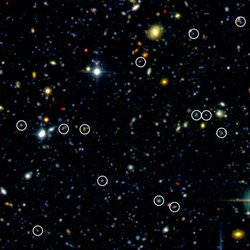
13 distant galaxies found in a sample of sky. Image credit: ESO. Click to enlarge.
It is one of the major goals of observational cosmology to trace the way galaxies formed and evolved and to compare it to predictions from theoretical models. It is therefore essential to know as precisely as possible how many galaxies were present in the Universe at different epochs.
This is easier to say than to do. Indeed, if counting galaxies from deep astronomical images is relatively straightforward, measuring their distance – hence, the epoch in the history of the universe where we see it [1] – is much more difficult. This requires taking a spectrum of the galaxy and measuring its redshift [2].
However, for the faintest galaxies – that are most likely the farthest and hence the oldest – this requires a lot of observing time on the largest of the telescopes. Until now, astronomers had thus to first carefully select the candidate high-redshift galaxies, in order to minimise the time spent on measuring the distance. But it seems that astronomers were too careful in doing so, and hence had a wrong picture of the population of galaxies.
It would be better to “simply” observe in a given patch of the sky all galaxies brighter than a given limit. But looking at one object at a time would make such a study impossible.
To take up the challenge, a team of French and Italian astronomers [3] used the largest possible telescope with a highly specialised, very sensitive instrument that is able to observe a very large number of (faint) objects in the remote universe simultaneously.
The astronomers made use of the VIsible Multi-Object Spectrograph (VIMOS) on Melipal, one of the 8.2-m telescopes of ESO’s Very Large Telescope Array. VIMOS can observe the spectra of about 1,000 galaxies in one exposure, from which redshifts, hence distances, can be measured. The possibility to observe two galaxies at once would be equivalent to using two VLT Unit Telescopes simultaneously. VIMOS thus effectively multiplies the efficiency of the VLT hundreds of times.
This makes it possible to complete in a few hours observations that would have taken months only a few years ago. With capabilities up to ten times more productive than competing instruments, VIMOS offers the possibility for the first time to conduct an unbiased census of the distant Universe.
Using the high efficiency of the VIMOS instrument, the team of astronomers embarked in the VIMOS VLT Deep Survey (VVDS) whose aim is to measure in some selected patch of the sky the redshift of all galaxies brighter than magnitude 24 in the red, that is, galaxies that are up to 16 million fainter than what the unaided eye can see.
In a total sample of about 8,000 galaxies selected only on the basis of their observed brightness in red light, almost 1,000 bright and vigorously star forming galaxies were discovered at an epoch 1,500 to 4,500 million years after the Big Bang (redshift between 1.4 and 5).
“To our surprise”, says Olivier Le F?vre, from the Laboratoire d’Astrophysique de Marseille (France) and co-leader of the VVDS project, “this is two to six times higher than had been found by previous works. These galaxies had been missed because previous surveys had selected objects in a much more restrictive manner than we did. And they did so to accommodate the much lower efficiency of the previous generation of instruments.”
While observations and models have consistently indicated that the Universe had not yet formed many stars in the first billion years of cosmic time, the discovery made by the scientists calls for a significant change in this picture.
Combining the spectra of all the galaxies in a given redshift range (i.e. belonging to the same epoch), the astronomers could estimate the amount of star formed in these galaxies. They find that the galaxies in the young Universe transform into stars between 10 and 100 times the mass of our Sun in a year.
“This discovery implies that galaxies formed many more stars early in the life of the Universe than had previously been thought”, explains Gianpaolo Vettolani, the other co-leader of the VVDS project, working at INAF-IRA in Bologna (Italy). “These observations will demand a profound reassessment of our theories of the formation and evolution of galaxies in a changing Universe.”
It now remains for astronomers to explain how one can create such a large population of galaxies, producing more stars than previously assumed, at a time when the Universe was about 10-20% of its current age.
Original Source: ESO News Release
